Spatio-Temporal Changes and Driving Forces Analysis of Urban Open Spaces in Shanghai between 1980 and 2020: An Integrated Geospatial Approach
Abstract
1. Introduction
- (1)
- How can we produce high-accuracy, high-precision open space mapping over long time series in Shanghai?
- (2)
- What have the spatio-temporal urban open space change dynamics been in Shanghai over the 40 years?
- (3)
- What were the main factors driving urban open space changes in Shanghai during the period of 1980–2020?
2. Study Area and Data Description
2.1. Study Area
2.2. Data Description
3. Methods
3.1. Google Earth Engine, Random Forest, Optimal Granularity
3.2. Comprehensive Methods to Open Space Changes
3.2.1. Open Space Ratio
3.2.2. Transition Matrix
3.2.3. Landscape Metrics
3.2.4. Fractal Dimension
3.2.5. Normalized Difference Vegetation Index
3.2.6. Theil–Sen Median Trend Analysis
3.3. Analyzing the Influencing Factors by Geodetector
4. Results
4.1. Classification Maps and Accuracy Assessment
4.2. Spatio-Temporal Trends Present in the Open Space Analysis
4.2.1. Composition Changes in Open Space
- (1)
- Open space ratio changes between 1980 and 2020
- (2)
- Open space changes: a directional perspective
- (3)
- Open space changes along the concentric buffers
4.2.2. Open Space Change Transitions
4.2.3. Landscape Metrics Analysis
4.2.4. Fractal Dimension
4.2.5. Shanghai NDVI
4.2.6. Theil–Sen Median Trend Analysis
4.3. Analysis of Driving Factors
5. Discussion
5.1. An Integrated Approach Describing the Spatiotemporal Dynamics of UOS
5.2. Understanding the Driving Policies on Urban Open Spaces Dynamics
5.3. Optimizing Strategy
6. Conclusions
Author Contributions
Funding
Data Availability Statement
Conflicts of Interest
References
- Schell, L.M.; Ulijaszek, S.J.; Schell, L.M.; Ulijaszek, S.J.; McMichael, A.J.; Clark, D.; Huss-Ashmore, R.; Behrman, C.; Diferdinando, G.; Ellison, P.T.; et al. Urbanism, Health and Human Biology in Industrialised Countries; Cambridge University Press: Cambridge, UK, 1999; ISBN 9780521620970. [Google Scholar]
- Haas, J.; Ban, Y. Urban Growth and Environmental Impacts in Jing-Jin-Ji, the Yangtze, River Delta and the Pearl River Delta. Int. J. Appl. Earth Obs. Geoinf. 2014, 30, 42–55. [Google Scholar] [CrossRef]
- Kim, K.-H.; Pauleit, S. Landscape Character, Biodiversity and Land Use Planning: The Case of Kwangju City Region, South Korea. Land Use Policy 2007, 24, 264–274. [Google Scholar] [CrossRef]
- Yuan, F.; Bauer, M.E. Comparison of Impervious Surface Area and Normalized Difference Vegetation Index as Indicators of Surface Urban Heat Island Effects in Landsat Imagery. Remote Sens. Environ. 2007, 106, 375–386. [Google Scholar] [CrossRef]
- Yeh, C.-T.; Huang, S.-L. Investigating Spatiotemporal Patterns of Landscape Diversity in Response to Urbanization. Landsc. Urban Plan. 2009, 93, 151–162. [Google Scholar] [CrossRef]
- Davies, R.G.; Barbosa, O.; Fuller, R.A.; Tratalos, J.; Burke, N.; Lewis, D.; Warren, P.H.; Gaston, K.J. City-Wide Relationships between Green Spaces, Urban Land Use and Topography. Urban Ecosyst. 2008, 11, 269–287. [Google Scholar] [CrossRef]
- Chen, W.Y.; Jim, C.Y. Assessment and Valuation of the Ecosystem Services Provided by Urban Forests. In Ecology, Planning, and Management of Urban Forests: International Perspectives; Carreiro, M.M., Song, Y.-C., Wu, J., Eds.; Springer: New York, NY, USA, 2008; pp. 53–83. ISBN 9780387714257. [Google Scholar]
- Wang, J.; Li, L.; Zhang, T.; Chen, L.; Wen, M.; Liu, W.; Hu, S. Optimal Grain Size Based Landscape Pattern Analysis for Shanghai Using Landsat Images from 1998 to 2017. Pol. J. Environ. Stud. 2021, 30, 2799–2813. [Google Scholar] [CrossRef] [PubMed]
- Wu, Z.; Chen, R.; Meadows, M.E.; Sengupta, D.; Xu, D. Changing Urban Green Spaces in Shanghai: Trends, Drivers and Policy Implications. Land Use Policy 2019, 87, 104080. [Google Scholar] [CrossRef]
- Li, J.; Li, C.; Zhu, F.; Song, C.; Wu, J. Spatiotemporal Pattern of Urbanization in Shanghai, China between 1989 and 2005. Landsc. Ecol. 2013, 28, 1545–1565. [Google Scholar] [CrossRef]
- Liu, S.; Zhang, X.; Feng, Y.; Xie, H.; Jiang, L.; Lei, Z. Spatiotemporal Dynamics of Urban Green Space Influenced by Rapid Urbanization and Land Use Policies in Shanghai. For. Trees Livelihoods 2021, 12, 476. [Google Scholar] [CrossRef]
- Amani, M.; Ghorbanian, A.; Ahmadi, S.A.; Kakooei, M.; Moghimi, A.; Mirmazloumi, S.M.; Moghaddam, S.H.A.; Mahdavi, S.; Ghahremanloo, M.; Parsian, S.; et al. Google Earth Engine Cloud Computing Platform for Remote Sensing Big Data Applications: A Comprehensive Review. IEEE J. Sel. Top. Appl. Earth Obs. Remote Sens. 2020, 13, 5326–5350. [Google Scholar] [CrossRef]
- Uy, P.D.; Nakagoshi, N. Analyzing Urban Green Space Pattern and Eco-Network in Hanoi, Vietnam. Landsc. Ecol. Eng. 2007, 3, 143–157. [Google Scholar] [CrossRef]
- Xu, H.; Cui, J. Assessing Changes in Green Space of Suzhou City Using Remote-Sensing Images and Landscape Metrics. TC 2016, 620, 45999-83. [Google Scholar]
- Kong, F.; Nakagoshi, N. Spatial-Temporal Gradient Analysis of Urban Green Spaces in Jinan, China. Landsc. Urban Plan. 2006, 78, 147–164. [Google Scholar] [CrossRef]
- Liu, J.; Zhang, L.; Zhang, Q.; Li, C.; Zhang, G.; Wang, Y. Spatiotemporal Evolution Differences of Urban Green Space: A Comparative Case Study of Shanghai and Xuchang in China. Land Use Policy 2022, 112, 105824. [Google Scholar] [CrossRef]
- Xiao, Z.; Tian, Y.; Hao, L. Evolution of Green Space Based on Remote Sensing Images in Zhengdong New District. Proc. Int. Wirel. Commun. Mob. Comput. Conf. 2022, 2022, 3599045. [Google Scholar] [CrossRef]
- Yang, J.; Zhang, F.; Shi, B. Analysis of Open Space Types in Urban Centers Based on Functional Features. E3S Web Conf. 2019, 79, 01009. [Google Scholar] [CrossRef]
- Ma, L.; Li, M.; Ma, X.; Cheng, L.; Du, P.; Liu, Y. A Review of Supervised Object-Based Land-Cover Image Classification. ISPRS J. Photogramm. Remote Sens. 2017, 130, 277–293. [Google Scholar] [CrossRef]
- Kong, F.; Nakagoshi, N. Changes of Urban Green Spaces and Their Driving Forces: A Case Study of Jinan City, China. J. Int. Dev. Coop. 2005, 11, 97–109. [Google Scholar]
- Tan, P.Y.; Wang, J.; Sia, A. Perspectives on Five Decades of the Urban Greening of Singapore. Cities 2013, 32, 24–32. [Google Scholar] [CrossRef]
- Zhou, X.; Wang, Y.-C. Spatial–temporal Dynamics of Urban Green Space in Response to Rapid Urbanization and Greening Policies. Landsc. Urban Plan. 2011, 100, 268–277. [Google Scholar] [CrossRef]
- Shu, B.; Zhang, H.; Li, Y.; Qu, Y.; Chen, L. Spatiotemporal Variation Analysis of Driving Forces of Urban Land Spatial Expansion Using Logistic Regression: A Case Study of Port Towns in Taicang City, China. Habitat Int. 2014, 43, 181–190. [Google Scholar] [CrossRef]
- Wang, J.; Xu, C. Geodetector: Principle and prospective. Acta Geogr. Sin. 2017, 72, 116–134. [Google Scholar]
- Yang, H.; Xu, T.; Chen, D.; Yang, H.; Pu, L. Direct Modeling of Subway Ridership at the Station Level: A Study Based on Mixed Geographically Weighted Regression. Can. J. Civ. Eng. 2020, 47, 534–545. [Google Scholar] [CrossRef]
- Mohamed, A.; Worku, H. Simulating Urban Land Use and Cover Dynamics Using Cellular Automata and Markov Chain Approach in Addis Ababa and the Surrounding. Urban Clim. 2020, 31, 100545. [Google Scholar] [CrossRef]
- Wu, S.; Wang, D.; Yan, Z.; Wang, X.; Han, J. Spatiotemporal Dynamics of Urban Green Space in Changchun: Changes, Transformations, Landscape Patterns, and Drivers. Ecol. Indic. 2023, 147, 109958. [Google Scholar] [CrossRef]
- Ouyang, X.; Tang, L.; Wei, X.; Li, Y. Spatial Interaction between Urbanization and Ecosystem Services in Chinese Urban Agglomerations. Land Use Policy 2021, 109, 105587. [Google Scholar] [CrossRef]
- Liu, C.; Xu, Y.; Lu, X.; Han, J. Trade-Offs and Driving Forces of Land Use Functions in Ecologically Fragile Areas of Northern Hebei Province: Spatiotemporal Analysis. Land Use Policy 2021, 104, 105387. [Google Scholar] [CrossRef]
- Shanghai Municipal Government (SMG). Shanghai Master Plan 2017–2035. 2018. Available online: http://www.shanghai.gov.cn/newshanghai/xxgkfj/2035004.pdf (accessed on 1 March 2023).
- Liu, J.; Liu, M.; Tian, H.; Zhuang, D.; Zhang, Z.; Zhang, W.; Tang, X.; Deng, X. Spatial and Temporal Patterns of China’s Cropland during 1990–2000: An Analysis Based on Landsat TM Data. Remote Sens. Environ. 2005, 98, 442–456. [Google Scholar] [CrossRef]
- Institute of Geographical Sciences and Resources Research, CAS, Resource and Environmental Science and Data Centre. Available online: https://www.resdc.cn (accessed on 27 May 2022).
- Huang, C.; Xu, N. Climatic Factors Dominate the Spatial Patterns of Urban Green Space Coverage in the Contiguous United States. Int. J. Appl. Earth Obs. Geoinf. 2022, 107, 102691. [Google Scholar] [CrossRef]
- Dobbs, C.; Nitschke, C.; Kendal, D. Assessing the Drivers Shaping Global Patterns of Urban Vegetation Landscape Structure. Sci. Total Environ. 2017, 592, 171–177. [Google Scholar] [CrossRef] [PubMed]
- USGS.gov. Science for a Changing World. Available online: https://earthexplorer.usgs.gov/ (accessed on 27 May 2023).
- Climatologylab. Available online: https://www.climatologylab.org/terraclimate.html (accessed on 27 June 2023).
- Chen, J.; Gao, M.; Cheng, S.; Hou, W.; Song, M.; Liu, X.; Liu, Y. Global 1 Km × 1 Km Gridded Revised Real Gross Domestic Product and Electricity Consumption during 1992–2019 Based on Calibrated Nighttime Light Data. Sci. Data 2022, 9, 202. [Google Scholar] [CrossRef] [PubMed]
- Open Spatial Demographic Data and Research. Available online: https://www.worldpop.org/ (accessed on 3 May 2023).
- Odiac-Fossil fuel CO2 emission data product. Available online: https://odiac.org/index.html (accessed on 27 May 2023).
- Kumar, L.; Mutanga, O. Google Earth Engine Applications since Inception: Usage, Trends, and Potential. Remote Sens. 2018, 10, 1509. [Google Scholar] [CrossRef]
- Tamiminia, H.; Salehi, B.; Mahdianpari, M.; Quackenbush, L.; Adeli, S.; Brisco, B. Google Earth Engine for Geo-Big Data Applications: A Meta-Analysis and Systematic Review. ISPRS J. Photogramm Remote Sens. 2020, 164, 152–170. [Google Scholar] [CrossRef]
- Belgiu, M.; Drăguţ, L. Random Forest in Remote Sensing: A Review of Applications and Future Directions. ISPRS J. Photogramm Remote Sens. 2016, 114, 24–31. [Google Scholar] [CrossRef]
- Breiman, L. Random Forests. Mach. Learn. 2001, 45, 5–32. [Google Scholar] [CrossRef]
- Rabiei-Dastjerdi, H.; Amini, S.; McArdle, G.; Homayouni, S. City-Region or City? That Is the Question: Modelling Sprawl in Isfahan Using Geospatial Data and Technology. GeoJournal 2022, 88 (Suppl. S1), 135–155. [Google Scholar] [CrossRef]
- Hansen, M.C.; Roy, D.P.; Lindquist, E.; Adusei, B.; Justice, C.O.; Altstatt, A. A Method for Integrating MODIS and Landsat Data for Systematic Monitoring of Forest Cover and Change in the Congo Basin. Remote Sens. Environ. 2008, 112, 2495–2513. [Google Scholar] [CrossRef]
- Pettorelli, N.; Vik, J.O.; Mysterud, A.; Gaillard, J.-M.; Tucker, C.J.; Stenseth, N.C. Using the Satellite-Derived NDVI to Assess Ecological Responses to Environmental Change. Trends Ecol. Evol. 2005, 20, 503–510. [Google Scholar] [CrossRef] [PubMed]
- Gao, B.-C. NDWI—A Normalized Difference Water Index for Remote Sensing of Vegetation Liquid Water from Space. Remote Sens. Environ. 1996, 58, 257–266. [Google Scholar] [CrossRef]
- Zha, Y.; Gao, J.; Ni, S. Use of Normalized Difference Built-up Index in Automatically Mapping Urban Areas from TM Imagery. Int. J. Remote Sens. 2003, 24, 583–594. [Google Scholar] [CrossRef]
- Xu, H. Modification of Normalised Difference Water Index (NDWI) to Enhance Open Water Features in Remotely Sensed Imagery. Int. J. Remote Sens. 2006, 27, 3025–3033. [Google Scholar] [CrossRef]
- Rennó, C.D.; Nobre, A.D.; Cuartas, L.A.; Soares, J.V.; Hodnett, M.G.; Tomasella, J.; Waterloo, M.J. HAND, a New Terrain Descriptor Using SRTM-DEM: Mapping Terra-Firme Rainforest Environments in Amazonia. Remote Sens. Environ. 2008, 112, 3469–3481. [Google Scholar] [CrossRef]
- Wang, Z.; Bai, T.; Xu, D.; Kang, J.; Shi, J.; Fang, H.; Nie, C.; Zhang, Z.; Yan, P.; Wang, D. Temporal and Spatial Changes in Vegetation Ecological Quality and Driving Mechanism in Kökyar Project Area from 2000 to 2021. Sustainability 2022, 14, 7668. [Google Scholar] [CrossRef]
- Behera, M.D.; Borate, S.N.; Panda, S.N.; Behera, P.R.; Roy, P.S. Modelling and Analyzing the Watershed Dynamics Using Cellular Automata (CA)–Markov Model—A Geo-Information Based Approach. J. Earth Syst. Sci. 2012, 121, 1011–1024. [Google Scholar] [CrossRef]
- Halmy, M.W.A.; Gessler, P.E.; Hicke, J.A.; Salem, B.B. Land Use/land Cover Change Detection and Prediction in the North-Western Coastal Desert of Egypt Using Markov-CA. Appl. Geogr. 2015, 63, 101–112. [Google Scholar] [CrossRef]
- Pontius, R.G.; Millones, M. Death to Kappa: Birth of Quantity Disagreement and Allocation Disagreement for Accuracy Assessment. Int. J. Remote Sens. 2011, 32, 4407–4429. [Google Scholar] [CrossRef]
- Wu, J. Effects of Changing Scale on Landscape Pattern Analysis: Scaling Relations. Landsc. Ecol. 2004, 19, 125–138. [Google Scholar] [CrossRef]
- Buyantuyev, A.; Wu, J.; Gries, C. Multiscale Analysis of the Urbanization Pattern of the Phoenix Metropolitan Landscape of USA: Time, Space and Thematic Resolution. Landsc. Urban Plan. 2010, 94, 206–217. [Google Scholar] [CrossRef]
- Fang, S.; Zhao, Y.; Han, L.; Ma, C. Analysis of Landscape Patterns of Arid Valleys in China, Based on Grain Size Effect. Sustain. Sci. Pract. Policy 2017, 9, 2263. [Google Scholar] [CrossRef]
- Teng, M.; Zeng, L.; Zhou, Z.; Wang, P.; Xiao, W.; Dian, Y. Responses of Landscape Metrics to Altering Grain Size in the Three Gorges Reservoir Landscape in China. Environ. Earth Sci. 2016, 75, 1055. [Google Scholar] [CrossRef]
- Yin, J.; Yin, Z.; Zhong, H.; Xu, S.; Hu, X.; Wang, J.; Wu, J. Monitoring Urban Expansion and Land Use/land Cover Changes of Shanghai Metropolitan Area during the Transitional Economy (1979–2009) in China. Environ. Monit. Assess. 2011, 177, 609–621. [Google Scholar] [CrossRef] [PubMed]
- Xu, J.; Liao, B.; Shen, Q.; Zhang, F.; Mei, A. Urban Spatial Restructuring in Transitional economy—Changing Land Use Pattern in Shanghai. Chin. Geogr. Sci. 2007, 17, 19–27. [Google Scholar] [CrossRef]
- Yu, Z.; Wang, Y.; Deng, J.; Shen, Z.; Wang, K.; Zhu, J.; Gan, M. Dynamics of Hierarchical Urban Green Space Patches and Implications for Management Policy. Sensors 2017, 17. [Google Scholar] [CrossRef] [PubMed]
- Biondini, M.; Kandus, P. Transition Matrix Analysis of Land-Cover Change in the Accretion Area of the Lower Delta of the Paraná River (Argentina) Reveals Two Succession Pathways. Wetlands 2006, 26, 981–991. [Google Scholar] [CrossRef]
- Feng, Y.; Liu, Y.; Tong, X. Spatiotemporal Variation of Landscape Patterns and Their Spatial Determinants in Shanghai, China. Ecol. Indic. 2018, 87, 22–32. [Google Scholar] [CrossRef]
- McGarigal, K.; Marks, B.J. FRAGSTATS: Spatial Pattern Analysis Program for Quantifying Landscape Structure; U.S. Department of Agriculture, Forest Service, Pacific Northwest Research Station: Portland, OR, USA, 1995.
- Lamine, S.; Petropoulos, G.P.; Singh, S.K.; Szabó, S.; Bachari, N.E.I.; Srivastava, P.K.; Suman, S. Quantifying Land Use/land Cover Spatio-Temporal Landscape Pattern Dynamics from Hyperion Using SVMs Classifier and FRAGSTATS®. Geocarto Int. 2018, 33, 862–878. [Google Scholar] [CrossRef]
- Versini, P.-A.; Gires, A.; Tchiguirinskaia, I.; Schertzer, D. Fractal Analysis of Green Roof Spatial Implementation in European Cities. Urban For. Urban Greening 2020, 49, 126629. [Google Scholar] [CrossRef]
- Aburas, M.M.; Abdullah, S.H.; Ramli, M.F.; Ash’aari, Z.H. Measuring Land Cover Change in Seremban, Malaysia Using NDVI Index. Procedia Environ. Sci. 2015, 30, 238–243. [Google Scholar] [CrossRef]
- Rouse, J.W., Jr.; Haas, R.H.; Schell, J.A.; Deering, D.W. Monitoring Vegetation Systems in the Great Plains with Erts. In NASA Special Publication; NASA, Goddard Space Flight Center 3d: Washington, DC, USA, 1974; Volume 351, p. 309. [Google Scholar]
- Burn, D.H.; Hag Elnur, M.A. Detection of Hydrologic Trends and Variability. J. Hydrol. 2002, 255, 107–122. [Google Scholar] [CrossRef]
- Wang, J.; Li, X.; Christakos, G.; Liao, Y.; Zhang, T.; Gu, X.; Zheng, X. Geographical Detectors-Based Health Risk Assessment and Its Application in the Neural Tube Defects Study of the Heshun Region, China. Int. J. Geogr. Inf. Sci. 2010, 24, 107–127. [Google Scholar] [CrossRef]
- Jenks, G.F. The Data Model Concept in Statistical Mapping. Int. Yearb. Cartogr. 1967, 7, 186–190. [Google Scholar]
- Byomkesh, T.; Nakagoshi, N.; Dewan, A.M. Urbanization and Green Space Dynamics in Greater Dhaka, Bangladesh. Landsc. Ecol. Eng. 2012, 8, 45–58. [Google Scholar] [CrossRef]
- Jim, C.Y. Monitoring the Performance and Decline of Heritage Trees in Urban Hong Kong. J. Environ. Manag. 2005, 74, 161–172. [Google Scholar] [CrossRef] [PubMed]
- Rafiee, R.; Salman Mahiny, A.; Khorasani, N. Assessment of Changes in Urban Green Spaces of Mashad City Using Satellite Data. Int. J. Appl. Earth Obs. Geoinf. 2009, 11, 431–438. [Google Scholar] [CrossRef]
- Zhang, L.; Wang, Z.; Da, L. Spatial Characteristics of Urban Green Space: A Case Study of Shanghai, China. Appl. Ecol. Environ. Res. 2019, 17, 1799–1815. [Google Scholar] [CrossRef]
- Pili, S.; Serra, P.; Salvati, L. Landscape and the City: Agro-Forest Systems, Land Fragmentation and the Ecological Network in Rome, Italy. Urban For. Urban Green. 2019, 41, 230–237. [Google Scholar] [CrossRef]
- Zhang, W.; Zhang, X.; Li, L.; Zhang, Z. Urban Forest in Jinan City: Distribution, Classification and Ecological Significance. Catena 2007, 69, 44–50. [Google Scholar] [CrossRef]
- Wolch, J.R.; Byrne, J.; Newell, J.P. Urban Green Space, Public Health, and Environmental Justice: The Challenge of Making Cities “just Green Enough”. Landsc. Urban Plan. 2014, 125, 234–244. [Google Scholar] [CrossRef]








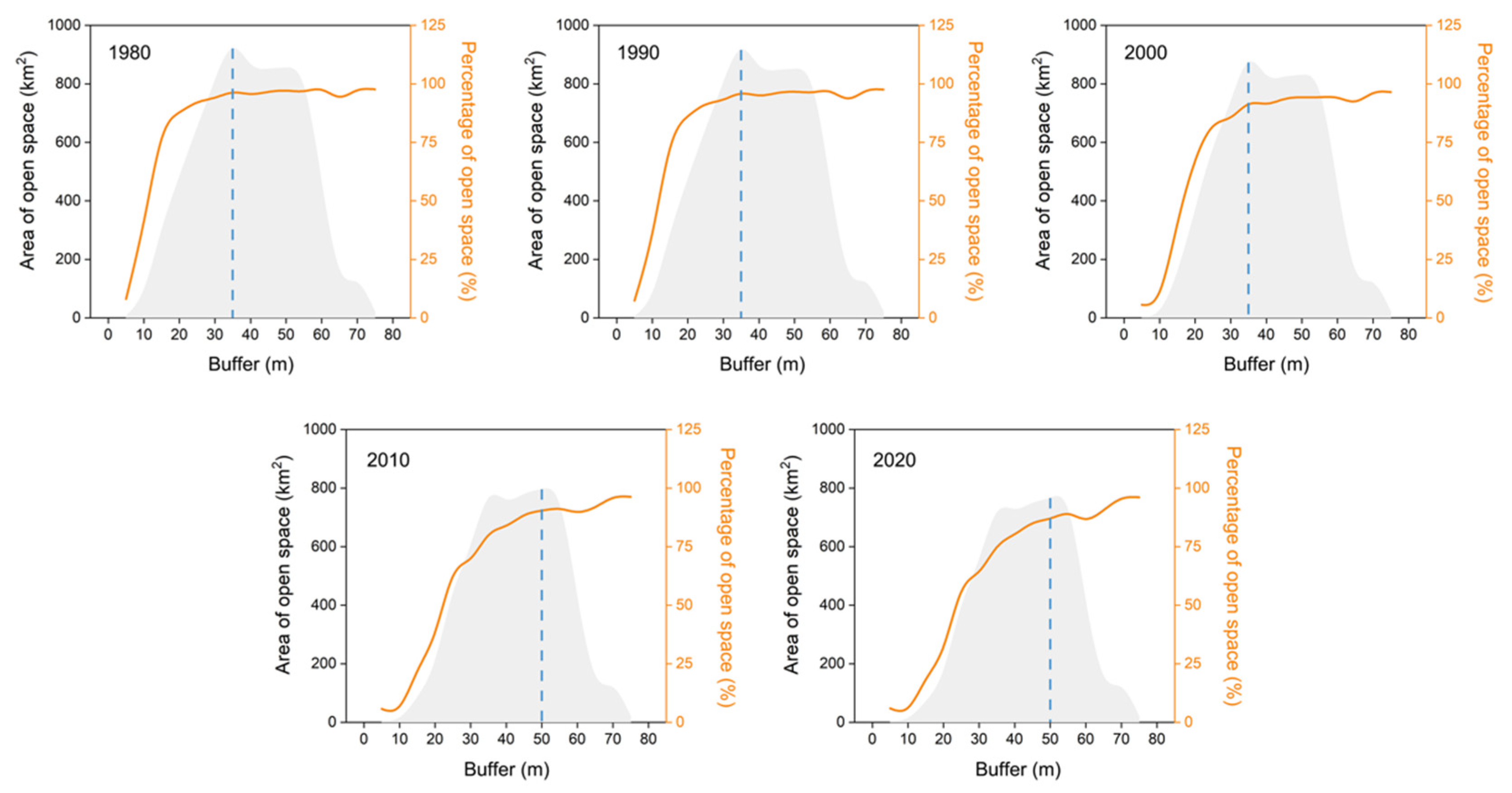
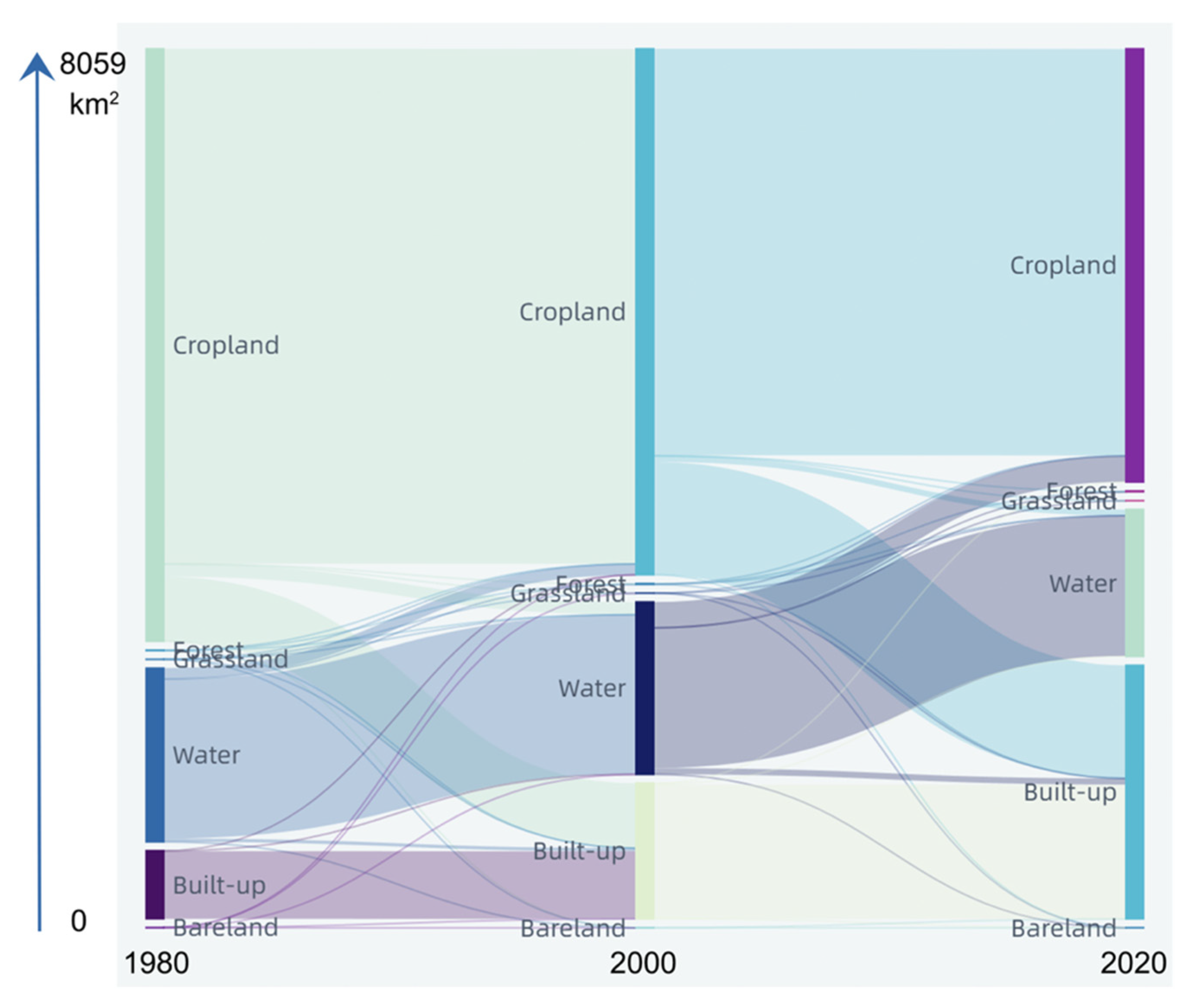
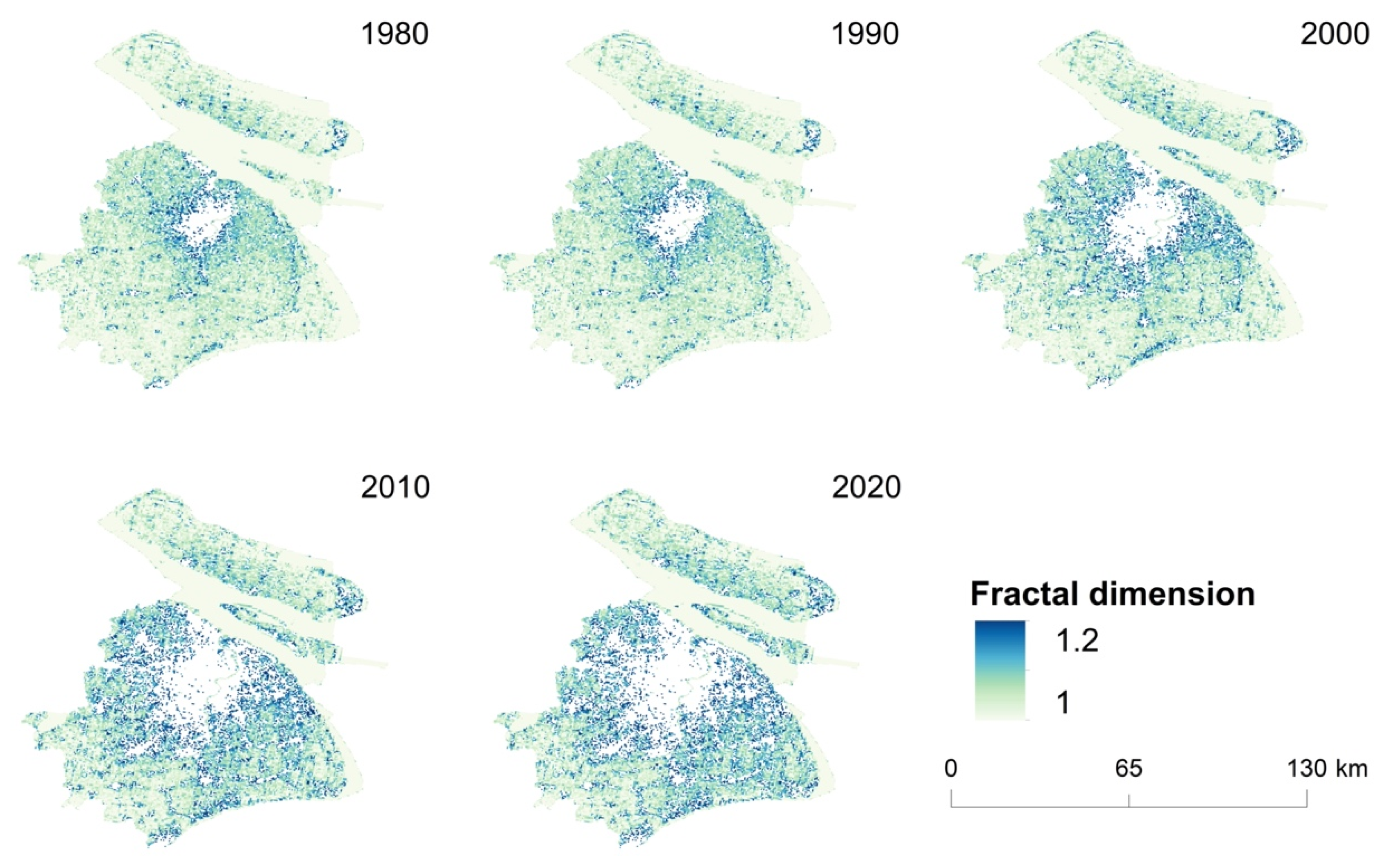
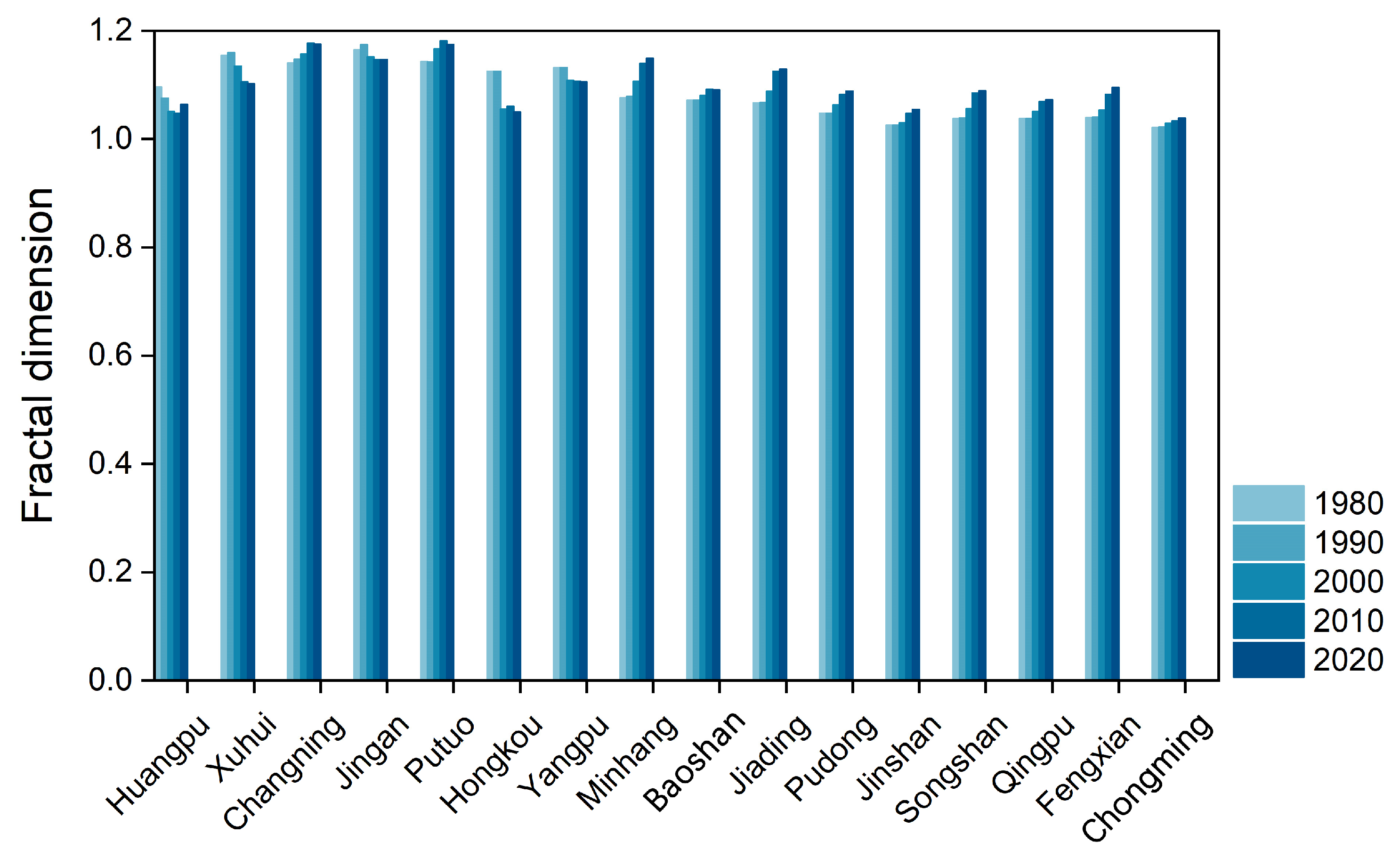

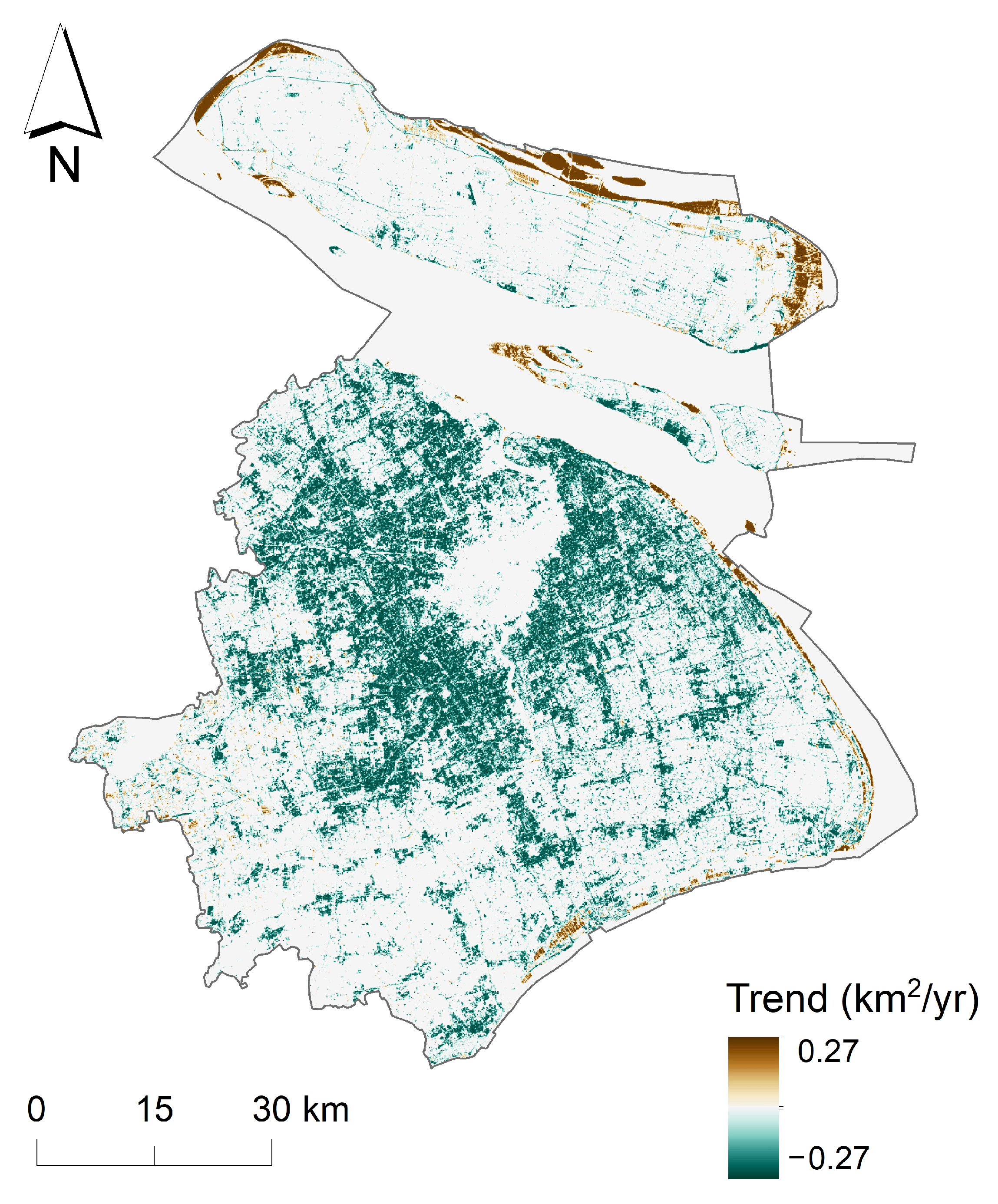

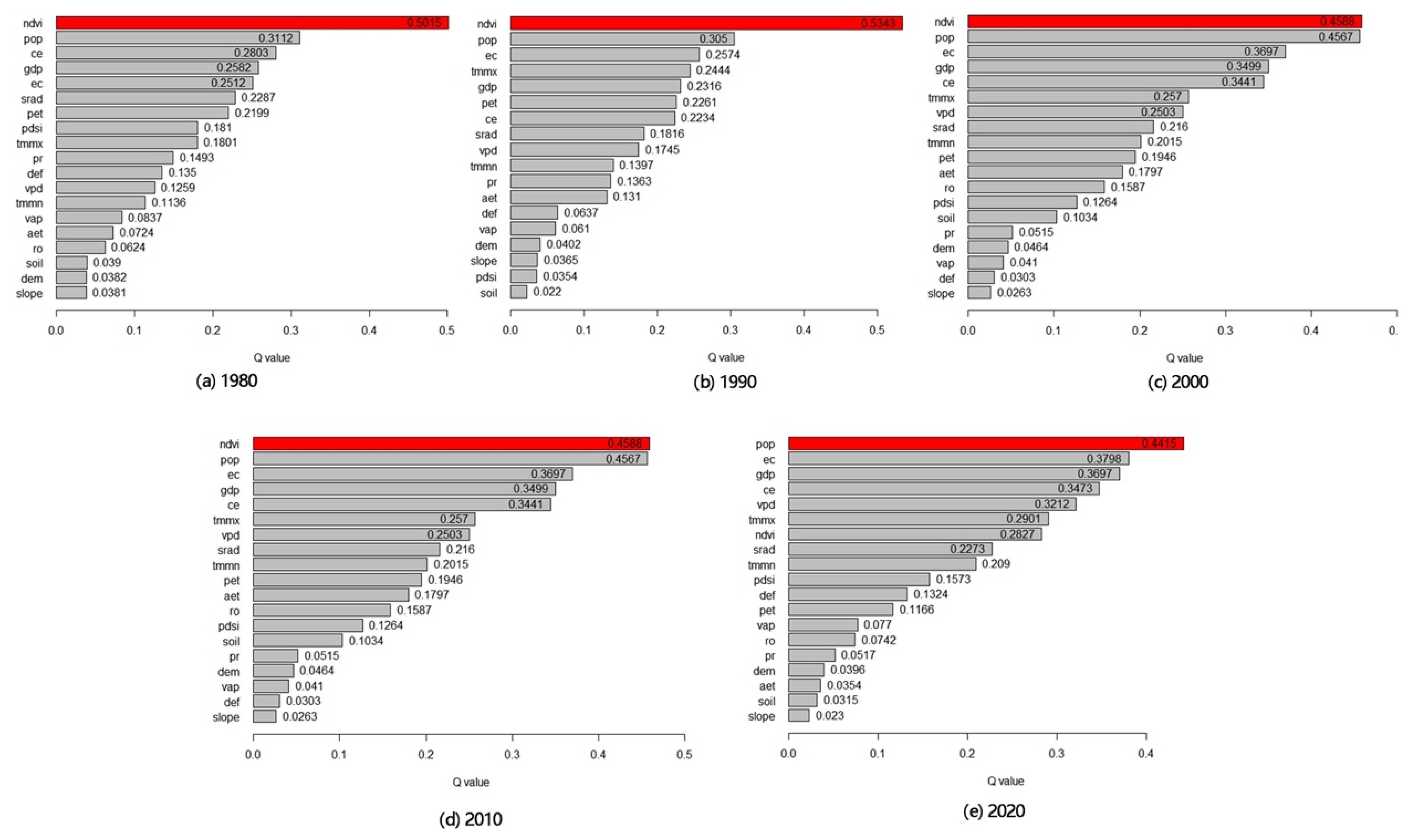

| Attributes | Category | Explanation |
|---|---|---|
| Open space | Cropland | Agricultural land and permanent crops, including vineyards, hop fields, gardens and orchards |
| Forest | Land for growing trees, shrubs, and bamboo, as well as coastal mangrove forest | |
| Grassland | Land for growing grasses, sedge, and shrubs | |
| Water | Natural land and water conservancy facilities | |
| Non-open space | Built area | Lands used for urban and rural settlements, Factories, and transportation facilities. |
| Unused land | Lands that are not put into practical used or are difficult to use |
| Variable Category | Code | Variable Name | Sources |
|---|---|---|---|
| Dependent variable | Y | Open space | Extracted from remote sensing images [35] |
| Natural geographic factors | X1 | Normalized Difference Vegetation Index (NDVI) | Extracted from remote sensing images [35] |
| X2 | DEM | [35] | |
| X3 | Slope | [35] | |
| X4 | Soil moisture (SOIL) | [36] | |
| X5 | Runoff (RO) | [36] | |
| Socioeconomic factors | X6 | Gross domestic product (GDP) | [37] |
| X7 | Population density (POP) | [38] | |
| X8 | Carbon emission density (CE) | [39] | |
| X9 | Electricity consumption (EC) | [37] | |
| Climatic factors | X10 | Precipitation (PR) | [36] |
| X11 | Maximum temperature (TMMX) | [36] | |
| X12 | Minimum temperature (TMMN) | [36] | |
| X13 | Vapor pressure difference (VPD) | [36] | |
| X14 | Actual evapotranspiration (AET) | [36] | |
| X15 | Solar radiation (SRAD) | [36] | |
| X16 | Potential evapotranspiration (PET) | [36] | |
| X17 | Palmer Drought Severity Index (PDSI) | [36] | |
| X18 | Atmospheric pressure (VAP) | [36] | |
| X19 | Climate water deficit (DEF) | [36] |
| Variable | Formulas | References |
|---|---|---|
| Normalized Difference Vegetation Index (NDVI) | (NIR − Red)/(NIR + Red) | [46] |
| Normalized Difference Water Index (NDWI) | (NIR − SWIR)/(NIR + SWIR) | [47] |
| Normalized Difference Built-up Index (NDBI) | (SWIR − NIR)/(NIR + SWIR) | [48] |
| Modified Normalized Difference Water Index (MNDWI) | (GREEN − SWIR)/(SWIR + SWIR) | [49] |
| Topographic Index | Elevation—Mean | [50] |
| Topographic Index | Slope—Mean | [50] |
| Landsat OLI Band 2 Blue | Blue | [51] |
| Landsat OLI Band 3 Green | Green | [51] |
| Landsat OLI Band 4 Red | Red | [51] |
| Landsat OLI Band 5 NIR | NIR | [51] |
| Landsat OLI Band 6 SWIR1 | SWIR1 | [51] |
| Landsat OLI Band 7 SWIR2 | SWIR2 | [51] |
| Abbreviations | Full Name | Unit | Application Level |
|---|---|---|---|
| TA | Total landscape area | ha | Landscape |
| NP | Number of patches | # | Class and Landscape |
| PD | Patch density | #/100 ha | Class and Landscape |
| LPI | Largest path index | % | Class and Landscape |
| ED | Edge density | m/ha | Class and Landscape |
| LSI | Landscape shape index | None | Class and Landscape |
| SHAPE-MN | Shape index—mean | None | Landscape |
| PAFRAC | Perimeter-area fractal dimension | None | Class and Landscape |
| CONTAG | Contagion | % | Landscape |
| PLADJ | Percent of landscape | % | Class and Landscape |
| IJI | Interspersion juxtaposition index | % | Class/Landscape |
| COHESION | Patch cohesion index | None | Class/Landscape |
| DIVISION | Landscape division index | % | Class/Landscape |
| SPLIT | Splitting index | None | Class/Landscape |
| SHDI | Shannon’s diversity index | None | Landscape |
| SHEI | Shannon’s evenness index | None | Landscape |
| AI | Aggregation index | % | Class/Landscape |
| T2 | Ai+ | Loss | |||||
|---|---|---|---|---|---|---|---|
| L1 | L2 | ⋯ | Ln | ||||
| T1 | L1 | A11 | A12 | ⋯ | A1n | A1+ | A1+ − A11 |
| L2 | A21 | A22 | ⋯ | A2n | A2+ | A2+ − A22 | |
| ⋮ | ⋮ | ⋮ | ⋮ | ⋮ | ⋮ | ⋮ | |
| Ln | An1 | An2 | ⋯ | Ann | An+ | An+ − Ann | |
| A+1 | A+1 | A+2 | ⋯ | A+n | |||
| Gain | A+1 − A11 | A+2 − A22 | ⋯ | A+n − Ann | |||
| Justification | Metrics | Units |
|---|---|---|
| Area and edge metrics | Edge density (ED) | m/ha |
| Total area (TA) | ha | |
| Shape metrics | Perimeter-area fractal dimension (PAFRAC) | dimensionless |
| Aggregation metrics | Aggregation index (AI) | % |
| Patch cohesion index (COHESION) | dimensionless | |
| Contagion index (CONTAG) | % | |
| Landscape shape index (LSI) | dimensionless | |
| Number of patches (NPs) | dimensionless | |
| Patch density (PD) | number/100 ha | |
| Proportion of like adjacencies (PLADJs) | % | |
| Splitting index (SPLIT) | dimensionless | |
| Landscape division index (DIVISION) | % | |
| Diversity metrics | Patch richness density (PRD) | number/100 ha |
| Shannon’s diversity index (SHDI) | dimensionless | |
| Shannon’s evenness index (SHEI) | dimensionless |
| Year | Cropland | Forest | Grassland | Water | Built-up | Bareland | Overall Accuracy | Kappa Coefficient | ||||||
|---|---|---|---|---|---|---|---|---|---|---|---|---|---|---|
| UA | PA | UA | PA | UA | PA | UA | PA | UA | PA | UA | PA | |||
| 1980 | 0.957 | 0.988 | 0.951 | 0.933 | 0.882 | 0.652 | 0.948 | 0.964 | 0.885 | 0.946 | 1 | 0.658 | 0.938 | 0.913 |
| 1990 | 0.951 | 0.993 | 0.928 | 0.936 | 0.889 | 0.762 | 0.964 | 0.89 | 0.921 | 0.952 | 0.921 | 0.795 | 0.934 | 0.907 |
| 2000 | 0.957 | 0.979 | 0.888 | 0.958 | 0.914 | 0.796 | 0.953 | 0.92 | 0.924 | 0.891 | 0.809 | 0.809 | 0.928 | 0.898 |
| 2010 | 0.942 | 0.981 | 0.962 | 0.962 | 0.883 | 0.791 | 0.978 | 0.957 | 0.875 | 0.927 | 0.904 | 0.904 | 0.933 | 0.903 |
| 2020 | 0.963 | 0.989 | 0.967 | 0.971 | 0.963 | 0.770 | 0.883 | 0.988 | 0.914 | 0.949 | 0.94 | 0.851 | 0.903 | 0.926 |
| Land-Use Type | 1980 | 1990 | 2000 | 2010 | 2020 | |
|---|---|---|---|---|---|---|
| OS1: Cropland | Area (km2) | 5719.2912 | 5590.098 | 5076.6678 | 4344.2685 | 4181.7807 |
| Percent (%) | 70.97 | 69.3669 | 62.9958 | 53.907 | 51.89 | |
| OS2: Forest | Area (km2) | 3.7485 | 3.7206 | 7.4781 | 12.9294 | 10.0332 |
| Percent (%) | 0.0465 | 0.04616 | 0.09279 | 0.160439 | 0.1245 | |
| OS3: Grassland | Area (km²) | 0.1638 | 0.1422 | 0.0405 | 3.3246 | 0.0891 |
| Percent (%) | 0.00203 | 0.001764 | 0.00050256 | 0.04125 | 0.00110 | |
| OS4: Water | Area (km2) | 1676.9322 | 1728.2043 | 1663.8174 | 1570.4055 | 1419.0417 |
| Percent (%) | 20.8088 | 21.4451 | 20.646 | 19.487002 | 17.6087 | |
| Total open space | Area (km2) | 7400.1357 | 7322.1651 | 6748.0038 | 5930.928 | 5610.9447 |
| Percent (%) | 91.827 | 90.86 | 83.73529 | 73.59628 | 69.625 | |
| NOS1: Built-up | Area (km2) | 657.3636 | 735.5268 | 1310.6466 | 2127.5253 | 2447.5698 |
| Percent (%) | 8.157 | 9.127 | 16.2636 | 26.4002 | 30.3716 | |
| NOS2: Bareland | Area (km2) | 1.2339 | 1.0413 | 0.0828 | 0.2799 | 0.2187 |
| Percent (%) | 0.0153 | 0.01292 | 0.00102746 | 0.00347 | 0.0027 | |
| Total: Non-open space | Area (km2) | 658.5975 | 736.5681 | 1310.7294 | 2127.8052 | 2447.7885 |
| Percent (%) | 8.173 | 9.14 | 16.2647 | 26.4037 | 30.3743 | |
| Periods | Land-Use Types | Cropland | Forest | Grassland | Water | Built-Up | Bareland |
|---|---|---|---|---|---|---|---|
| 1980–2000 | Cropland | 4969.49 | 3.99 | 0.03 | 121.08 | 624.71 | 0.00 |
| Forest | 1.21 | 2.44 | 0.00 | 0.03 | 0.07 | 0.00 | |
| Grassland | 0.00 | 0.00 | 0.01 | 0.01 | 0.14 | 0.00 | |
| Water | 105.12 | 1.05 | 0.00 | 1538.74 | 32.00 | 0.03 | |
| Built-up | 0.85 | 0.00 | 0.00 | 3.93 | 652.58 | 0.00 | |
| Bareland | 0.00 | 0.00 | 0.01 | 0.03 | 1.14 | 0.05 | |
| 2000–2020 | Cropland | 3922.93 | 6.75 | 0.08 | 57.10 | 1089.68 | 0.12 |
| Forest | 4.41 | 2.61 | 0.00 | 0.16 | 0.29 | 0.00 | |
| Grassland | 0.00 | 0.00 | 0.00 | 0.00 | 0.04 | 0.00 | |
| Water | 249.00 | 0.67 | 0.01 | 1354.78 | 59.28 | 0.09 | |
| Built-up | 5.45 | 0.00 | 0.00 | 7.00 | 1298.20 | 0.00 | |
| Bareland | 0.00 | 0.00 | 0.00 | 0.00 | 0.07 | 0.01 |
| Year | ED | TA | PAFRAC | AI | COHESION | CONTAG | LSI | NP | PD | PLADJ | SPLIT | DIVISION | PRD | SHDI | SHEI |
|---|---|---|---|---|---|---|---|---|---|---|---|---|---|---|---|
| 1980 | 23.93 | 10.74 | 2.94 | 95.52 | 97.14 | 32.92 | 1.18 | 2.05 | 18.80 | 86.09 | 1.11 | 0.08 | 13.59 | 0.13 | 0.18 |
| 1990 | 24.19 | 10.74 | 1.61 | 95.53 | 97.20 | 32.74 | 1.19 | 2.04 | 18.75 | 86.05 | 1.12 | 0.08 | 13.63 | 0.13 | 0.19 |
| 2000 | 31.45 | 10.74 | 3.51 | 94.61 | 96.64 | 32.78 | 1.25 | 2.25 | 20.63 | 84.96 | 1.20 | 0.12 | 14.15 | 0.18 | 0.26 |
| 2010 | 41.92 | 10.74 | 9.43 | 93.18 | 96.03 | 32.48 | 1.33 | 2.60 | 23.90 | 83.39 | 1.29 | 0.17 | 14.77 | 0.24 | 0.34 |
| 2020 | 44.24 | 10.74 | 8.48 | 92.91 | 95.86 | 32.97 | 1.35 | 2.68 | 24.57 | 83.04 | 1.32 | 0.18 | 14.99 | 0.25 | 0.37 |
| Year | P (m) | A (m2) | D |
|---|---|---|---|
| 1980 | 27,303.90 | 5723.20 | 2.04 |
| 1990 | 28,324.92 | 5593.96 | 2.05 |
| 2000 | 35,013.42 | 5084.19 | 2.13 |
| 2010 | 43,279.32 | 4360.52 | 2.22 |
| 2020 | 43,110.24 | 4191.90 | 2.23 |
Disclaimer/Publisher’s Note: The statements, opinions and data contained in all publications are solely those of the individual author(s) and contributor(s) and not of MDPI and/or the editor(s). MDPI and/or the editor(s) disclaim responsibility for any injury to people or property resulting from any ideas, methods, instructions or products referred to in the content. |
© 2024 by the authors. Licensee MDPI, Basel, Switzerland. This article is an open access article distributed under the terms and conditions of the Creative Commons Attribution (CC BY) license (https://creativecommons.org/licenses/by/4.0/).
Share and Cite
Zhu, Y.; Ling, G.H.T. Spatio-Temporal Changes and Driving Forces Analysis of Urban Open Spaces in Shanghai between 1980 and 2020: An Integrated Geospatial Approach. Remote Sens. 2024, 16, 1184. https://doi.org/10.3390/rs16071184
Zhu Y, Ling GHT. Spatio-Temporal Changes and Driving Forces Analysis of Urban Open Spaces in Shanghai between 1980 and 2020: An Integrated Geospatial Approach. Remote Sensing. 2024; 16(7):1184. https://doi.org/10.3390/rs16071184
Chicago/Turabian StyleZhu, Yaoyao, and Gabriel Hoh Teck Ling. 2024. "Spatio-Temporal Changes and Driving Forces Analysis of Urban Open Spaces in Shanghai between 1980 and 2020: An Integrated Geospatial Approach" Remote Sensing 16, no. 7: 1184. https://doi.org/10.3390/rs16071184
APA StyleZhu, Y., & Ling, G. H. T. (2024). Spatio-Temporal Changes and Driving Forces Analysis of Urban Open Spaces in Shanghai between 1980 and 2020: An Integrated Geospatial Approach. Remote Sensing, 16(7), 1184. https://doi.org/10.3390/rs16071184








